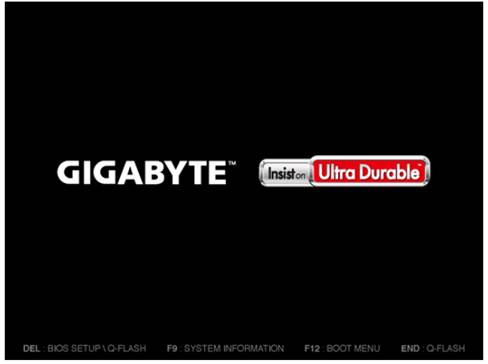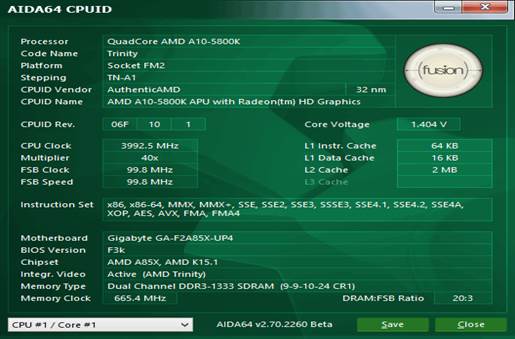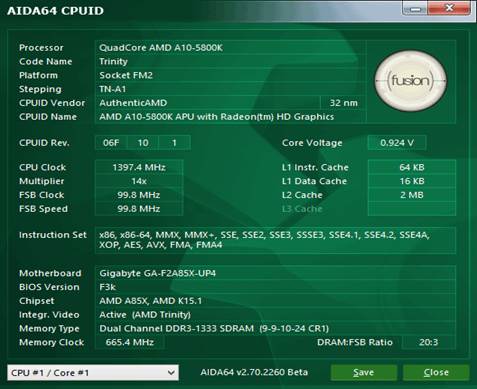We conducted all of our tests based on the
following components:
·
Gigabyte GA-F2A85X-UP4 rev.1.0 mainboard (Socket
FM2,AMD A85X, BIOS version F3k);
·
AMD A10-5800K CPU (3.8-4.2 GHz, 4 cores, AMD
Radeon HD 7660D 800 MHz, 32 nm, 100 W, 0.825-1.475 V, FM2);
·
2 x 4 GB DDR3 SDRAM Corsair Vengeance
CMZ16GX3M4X1866C9R (1866 MHz, 9-10-9-27 timings, 1.5 V voltage);
·
Crucial m4 SSD (CT256M4SSD2, 256 GB, SATA 6
Gbps);
·
Noctua NH-D14 CPU cooler;
·
ARCTIC MX-2 thermal interface;
·
Enermax NAXN ENM850EWT PSU;
·
Open testbed built using Antec Skeleton system
case.
We used the
Microsoft Windows 8 Enterprise 64 bit OS (Microsoft Windows, version 6-2, Build
9200), AMD Chipset with version 12.10 driver, AMD Catalyst graphics card with
version 12.10 driver).
Operational and overclocking specifics
Normally, system installed on Gigabyte
GA-F2A85X-UP4 works very well and problem seldom happens. The installation
process of Socket FM2 coolers is the same as in the previous AMD processors, so
we have no issue in installing Noctua NH-D14, the component that was original
located in Socket AM2 and AM3 processors. This, however, is a positive point
compared to a mess that we can face after finishing our installation process on
the mainboard for the Intel LGA 775, 1156 and 1155, 1366 and 2011 processors.

Starting
screen
When starting up, we see an eye-catching
image appear kindly. There, Gigabyte reminds us of all supportive hot keys. You
can disable the start-up background, but there would be no information
displayed on the screen. You can use the F9 button to have it display the basic
information of the system, just like in BIOS. We do not think that is a
concern, because the current mainboard startup quite fast that we are, in fact,
not able to observe the display of the information on the screen. No matter how
it is, you never have enough time to read all of that information. Moreover,
sometimes it is also a challenge even when you approach BIOS. Some mainboard
manufacturers start launching software and hardware devices allowing
approaching BIOS automatically.
The new Microsoft 8 Enterprise 64 bit OS is
quickly installed and has no problem. Our first impression is that this OS is
not absolutely perfect but is not really bad either. The installation
experience and Windows 8 configuration is the same as Windows 7, but a little
more difficult. For example, configuration setting can now be found not only by
the traditional way of “Control Panel” but also by the “PC setting” windows,
designed as a new part of the interface. The startup and reset process now have
so many steps that in order to make it easier, we have to create a shortcut
button using “shutdown” command. Therefore, if you are using Windows 7, there
is no reason which is good enough for you to switch to Windows 8. However, if
you are going to buy a new computer system, you should not neglect the new
operating system that you will get used to at last.
The key advantage of the Socket FM2
processor is the integrated graphics cores with the powerful speed, so now we do
not use any discrete graphics accelerators in our test. With the maximum speed
of AMD Radeon HD 7660D, the integrated graphics core works at the speed of 800
MHz, although in the idle mode, this frequency reduces to 300MHz.

Graphics
Processor Properties
The nominal frequency of AMD A10-5800K
processor is 3.8 GHz, but in many case that it works at the 4.0 GHz frequency

The
normal working frequency
When the data loading process works
smoothly, “Core Performance Boost” technologies can accelerate the CPU’s fan
speed up to 4.2 GHz.

Core
Performance Boost
However, if the CPU is in idle mode, the
power saving technology will reduce the voltage and frequency to 1.4 GHz.

Frequency
in idle mode
This has a direct resemblance of the “Intel
Turbo Boost” technology, but the operational principals of “Core Performance
Boost” pose many questions and cause many problems even. For instance, we
failed to measure the power consumption level of the system when the CPU was
working with its whole capacity. Normally, we used LinX program for the power
consuming tests and changed the number of computing threads. First of all, we
measured the power consumed in idle mode. Next came the case that the system
just ran one random program, but once we reached this status and the machine
was loading at most four programs, we would confront with some challenges. The
power consumption was usually quickly stable when opening files. Then it
started to constantly rise because the resistance increased with the
temperature. However, we found out the opposite fact happening in the system:
power consumption process decreased as time went by. It turned out that the
processor decreased its operating frequency, sometime under the nominal
frequency, to 3.4 GHz. LinX utility led to the overload in the CPU, but with
even Prime95 tools, the result was still the same: it is almost right after
starting the test, the frequency of the processor decreased.
The problem is when the processors could
not implement its functionality as chosen setting and lowered them was not
mysterious but attributed to over-clocking. There would be no problem if you
installed these optimistic configurations manually with efforts and increased
the clock frequency of the CPU, or if the processor manufacturer decided to go
with the un-real nominal high-profile configurations to eliminate the latency
in operating process and hide the weaknesses. The result is the same in both
cases: CPU is overclocked too much and it cannot maintain the expected
parameters and thus its speed was decreased. When we test an overclocked
system, we dismiss selected configuration: “Screenshot overclocking”, when the
processor is overclocked and just able to implement some simple tasks, but
turns back to the under peek operational load, it has no practical value. We
will not be able to take the full advantages of this potential mode. When it is
necessary and thus, we right away lower its core and CPU’s clock to determine
parameters at which it is able to work fully in a continuous period of time,
not a short time. Unfortunately, this unstable overclocking status is the
nominal mode of AMD A10-5800K processor.